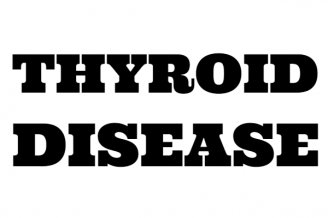
Thyroid Disease Different conditions of the thyroid gland mostly fall into these three categories:
- Hypothyroidism: This is the under-functioning of the thyroid.
- Hyperthyroidism: This is the over-functioning of the thyroid.
- Euthyroid: This refers to there being normal functioning of the thyroid.
The thyroid
The thyroid gland is part of the endocrine (gland) system in the body. The endocrine system is useful for doing things like making adrenalin, insulin, hormones, and many other important secretions. The thyroid gland makes thyroid hormones, and four pockets of parathyroid glands within it make parathormone (parathyroid hormone), which affects the balance of calcium for our bones. Removing the entire thyroid gland will also remove the parathyroid glands, a surgical caveat that became apparent as soon as thyroid surgery was developed.
The thyroid itself is a butterfly-shaped gland that covers the trachea (windpipe) below the Adam’s apple. Its main hormone, thyroxine (T4), breaks down into tri-iodothyronine (T3), which controls the body’s rate of metabolism, growth, and body temperature. The thyroid relies on iodine to make its hormones, and those without seafood in the diet require other sources of iodine, such as iodized salt, cranberries, strawberries, cheese, potatoes, or navy beans.
Hypothyroidism and Hyperthyroidism
Hypothyroidism is the condition in which the thyroid is not making enough thyroxine (T4). This can be seen in other types of thyroid conditions (see below), but generally a person with hypothyroidism will demonstrate a generalized slowing of his or her metabolism over time. Patients will often demonstrate the following conditions:
- Weight gain;
- Decreased sweating;
- Fatigue;
- Cold intolerance;
- Constipation;
- Dry skin, brittle nails, and thinning hair;
- Depression;
- Irregular menstrual cycles and infertility;
- High cholesterol and, with it, heart disease;
- Water retention that causes swelling (myxedema).
Causes of hypothyroidism
- Primary hypothyroidism: This is intrinsic disease of the thyroid and involves the gland failing to make enough T4 (thyroxine) and T3.
- Disease of glands that secrete stimulants for the thyroid to function, such as the pituitary gland and the hypothalamus: The hypothalamus makes hormones that stimulate the pituitary to make the thyroid stimulating hormone(TSH) that stimulates the thyroid to make its T3 and T4.
- Drug-induced: Lithium can cause it, and iodine-containing drugs can temporarily cause it.
- Dietary deficiency of iodine: Without iodine, the thyroid can’t make its hormones.
- Hashimoto’s thyroiditis, which is an autoimmune disease in which the thyroid is attacked and destroyed by one’s own immune system, causing either a goiter or atrophy: This is the most common cause outside of iodine deficiency.
- Treatment with radiation, as with throat cancer.
Hyperthyroidism is an overactive thyroid gland. Generally-speaking, the metabolism in is augmented in this condition. Typically, patients with it will demonstrate the following:
- Weight loss;
- Increased sweating;
- Anxiety, emotional outbursts, tremor, palpitations;
- Heat intolerance;
- Frequent bowel movements (not diarrhea) from increased appetite;
- Menstrual irregularities or absence;
- Erectile dysfunction;
- Thyroid storm.
Causes of hyperthyroidism
- Grave’s disease, an autoimmune disease, is the most common cause of hyperthyroidism. This is an attack on the thyroid’s thyroid stimulating hormone receptors, prompting elevated T4 production and release.
- Toxic adenoma and toxic goiter: These occur from the overgrowth of thyroid tissue that has a runaway production of T4 independent of the normal rheostat nature of the hypothalamus-pituitary-thyroid axis.
- Reproductive organ tumors can overproduce T4, thereby unleashing its powers over the metabolism. Ovarian tumors (dermoid cysts or teratomas) can have functioning thyroid tissue with runaway T4 production. Other pregnancy-related tumors can produce too much of the hCG hormone, which is similar in structure to T4 and has a crossover of effects.
- Pituitary tumor, which can make excessive amounts of the thyroid stimulating hormone.
How are disorders of the thyroid gland treated?
Treatment depends on which type of functioning has gone astray. Whether increasing or decreasing thyroid function is necessary to correct a disorder of the thyroid gland, the main goal is reaching what is called a euthyroid state, which, as mentioned above, means the thyroid is functioning normally.
Treatment of hypothyroidism
- Primary hypothyroidism is treated by simply replacing what the gland cannot make.
Thyroid hormone (thyroxine, or T4) has been synthesized as levothyroxine (Synthroid). The TSH levels are elevated because TSH is trying to compensate for low thyroid activity by stimulating T4 production. Therefore, treatment success can be monitored by the TSH returning to normal levels, as well as reduction in any goiter and reduction of hypothyroid symptoms.
Treatment of hyperthyroidism
Hyperthyroidism, the opposite of hypothyroidism, prompts the pituitary gland to rectify the situation by decreasing its amount of the thyroid stimulating hormone. Because T3 and T4 are the thyroid hormones, both or either can be elevated with hyperthyroidism. The treatment approach is the following:
- Treat the cause if tumor-related, pregnancy-related, or autoimmune-related.
- Correct the thyroid abnormality’s symptoms with beta-blockers to tone down fast pulse, palpitations, anxiety, and tremors, etc.
- Decrease the synthesis of thyroid hormones through the use of antithyroid drugs.
These have side effects, so a treatment protocol can be adjusted in accordance with patient comfort and safety. Radioactive iodine, one of the antithyroid drugs, is contraindicated in pregnancy.
It’s hard to believe that an ounce of tissue can be so important, but like most of the body’s parts, it will be missed if it ceases to function properly. Hypo- and hyper-functioning of the thyroid are deviations from how the thyroid normally works and results in hypothyroidism and hyperthyroidism, respectively. The goal of treatment is to manipulate the dysfunction back into a euthyroid state.
